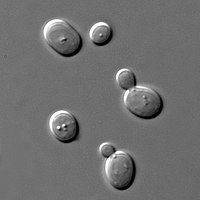
Photo from wikipedia
Sake, a traditional Japanese rice wine, contains various oligosaccharides (Sake oligosaccharides; SAOs) derived from rice starch. We previously found that SAOs reach a high degree of polymerization (DP). In this… Click to show full abstract
Sake, a traditional Japanese rice wine, contains various oligosaccharides (Sake oligosaccharides; SAOs) derived from rice starch. We previously found that SAOs reach a high degree of polymerization (DP). In this study, we developed a hydrophilic interaction liquid chromatography-time-of-flight/mass spectrometry (HILIC-TOF/MS) based analytical method to separate isomeric SAOs. Isomers of SAOs with DP = 6, 7, and 8, which were named DP6-1, DP7-1, DP8-1 and DP8-2, respectively, were purified from sake and their structures were determined by two-dimensional NMR spectroscopy. These were novel oligosaccharides containing two α-1, 6 bonded branches on an α-1, 4-linked glucose main chain. Interestingly, adjacent double α-1, 6 branches that have not been identified in starch, were found in DP6-1, DP7-1, and DP8-1, suggesting the presence of the branching pattern in starch. DP6-1 was poorly digested by fungal glucoamylase, and this may be attributed to its adjacent double branches at the non-reducing end.
Journal Title: Carbohydrate polymers
Year Published: 2021
Link to full text (if available)
Share on Social Media: Sign Up to like & get
recommendations!